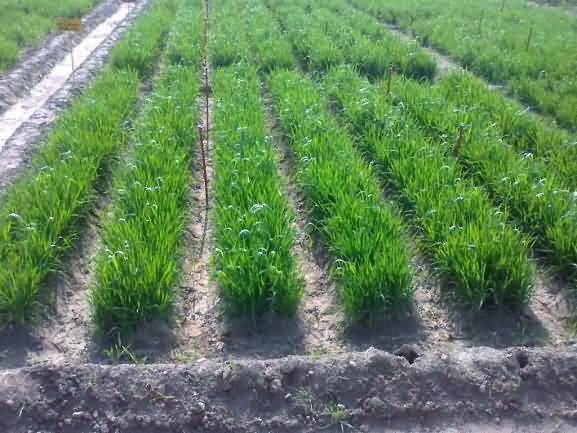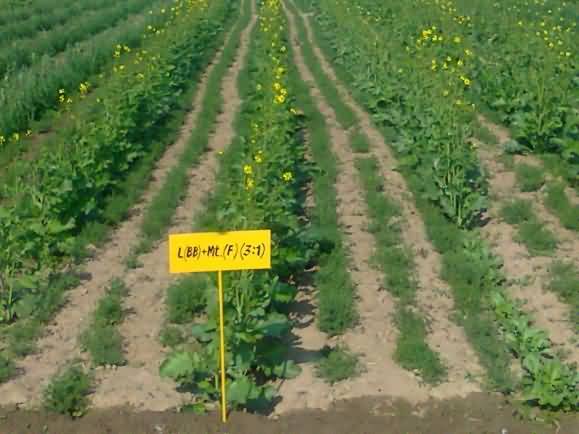फसलों की रोपाई की नाली सिचित उभरी क्यारी प्रणाली और फसल उत्पादन में उभरी क्यारी रोपाई के फायदे
In bed planting systems, wheat or other crops are planted on the raised beds in ridge - furrow system. This system is often considered more appropriate for growing high value crops that are more sensitive to temporary water logging stress. Farmers often raise crops such as cotton, maize-soybean and wheat on the raised beds. However, the practice of growing rice, the major water-using crop in rice-wheat systems, on narrow raised beds was introduced only very recently in the Indo-Gangetic Plains (IGP) to reduce water use, conserve rainwater and improve system productivity.
Recent work shows that system of raised bed planting of crops may be particularly advantageous in areas where groundwater levels are falling and herbicide-resistant weeds are becoming a problem.
This tillage and crop establishment option also facilitates crop diversification and intercropping of wheat, chickpea and Indian-mustard with sugarcane, maize with potato, mint with wheat, rice with soybean, and pigeon pea with sorghum or green gram.
Although bed planted wheat in rotation with soybeans covered more than 75% area under wheat by 1994 in Mexico, the South Asian rice-wheat farmers are still experimenting with this system of crop planting in the Indo-Gangetic Plains to address issues of receding water tables, crop losses due to temporary water logging in monsoon season and declining factor productivity and for crop diversification.
Results of farmer participatory trials indicate that significant water savings can be affected by planting rice (major consumer of irrigation water in rice-wheat systems) on raised bed besides improvement in crop yields.
Potential of Raised beds planting
Change over from growing crops in flat to ridge-furrow system of planting crops on raised bed alters the crop geometry and land configuration, offers more effective control over irrigation and drainage as well as their impacts on transport and transformations of nutrients, and rainwater management during the monsoon season.
In furrow irrigated raised bed (FIRB) system, water moves horizontally from the furrows into the beds (subbing) and is pulled upwards in the bed towards the soil surface by capillarity, evaporation and transpiration, and downwards largely by gravity. In determining the dimensions of the beds, factors such as spacing between tractor tyres, soil types, rainfall and groundwater conditions, salinity and irrigation water quality and requirements of crops grown in rotation are of prime importance.
For developing a permanent system of bed planting, factors like irrigation and fertilizer management, crop residue management, inter-tillage and weed management must be considered together. For major soil types (sandy loam to loam soils) and crops (inter-row crop spacing requirement) grown in the IGP, ridge-furrow system, of 67cm width (top width of bed-37cm; and of furrow-30cm) is often considered appropriate.
On the raised beds, two rows of rice, wheat, maize or chickpea are generally grown. Yields with 2 and 3 rows of wheat per bed are comparable, but lodging is greater with 3 rows per bed.
It is advantageous to plant on beds a single row of pigeon pea or intercropped wheat /mustard with furrow planted sugarcane. For effective weed control, choice of crop cultivars that cover the surface early in the season is of great importance.

Raised bed planting of wheat

Intercropping of Mustard + Lentil on Raised bed
Advantages:
There are several advantages associated with bed planting systems, which are as follows:
- Management of irrigation water is improved is simpler, and more efficient. On an average it uses, 30% less water than flat bed methods and improves crop yields by more than 20%. FIRB planting saves 30% to 50% wheat seed compared to flat bed planting.
- Better upland crop production is possible in the wet monsoon because of better drainage. Fertilizer efficiency can be increased because of better placement including top dress applications.
- Wheat seed rates are lower. Plant stands are better.
- Better tillering, increased panicle/ear length and bolder grain.
- Farmers can apply N and irrigation water at grain filling stage in wheat to improve protein content without lodging. Reduced lodging can have a significant, positive effect on yield as many farmers do not irrigate after heading precisely to avoid lodging. As a result, water can become a limiting factor during grain filling, resulting in lower yields.
- Bed planting facilitates irrigation before sowing and thus provides an opportunity for weed control prior to planting. If pre-sowing irrigation is likely to delay planting, bed planted crops can be irrigated immediately after seeding.
- Weeds between the beds can be controlled mechanically, early in the crop cycle.
- Herbicide dependence is reduced, and hand weeding and rouging between rows are easier. The major weed species affecting wheat, Phalaris minor, is less prolific on dry tops of raised beds than on the wetter soil found in conventional flat bed planting. Raised beds make it easier to apply herbicides because the beds allow the person spraying to follow the line. They also make possible mechanical weeding , and easier rouging or hand weeding.
- On raised beds, border effects allows the canopy to intercepts more solar radiation, it strengthens the straws, and the soil around the base of the plant is drier to prevent crop from lodging.
- In hand harvested rice fields, wheat crop can be planted in just one pass. The bed planter reshapes the beds and furrows, plants the crop and places fertilizer at appropriate depth into the soils along seed or between seed rows in the centre of the bed at 5-10cm depth. In combine harvested rice fields, crop straws can be incorporated into the beds using a shovel type furrow openers fixed on the front bar of the bed planter frame. In the absence of appropriate machinery, farmers partial layer interactions and less burn the rice straws before seeding of wheat.
- Yield potential is enhanced through improved nutrient-water lodging.
- Yield of rice transplanted on FIRB is comparable with traditional rice culture with as much as 25%-50% saving in irrigation water.
- Compaction of soil is limited only to the furrows used as tramlines (tractor tracks).
Conservation Tillage with Raised Beds
Research into permanent bed systems started at CIMMYT, Mexico, is showing encouraging results. An additional advantage of bed planting becomes apparent when beds are “permanent”, that is, when they are maintained over the medium term and not broken down for every crop. Making of permanent beds can help overcome constraints of resource depletion and pollution of existing systems. This has the potential of reducing cost of rice-wheat cultivation by 20%-25% over conventional methods. In this system, wheat is harvested and straw is left or burnt. The beds are reshaped by passing a shovel down the furrows. The next crop (soybean, maize, sunflower, cotton, etc.) can then be planted into the stubble in the same bed. The advantages of this system are reduced costs, erosion control, reduced soil compaction and, perhaps, better soil physical structure over time.
Zero-tillage, stubble management and reduction of herbicide use are some of the possibilities that would maintain soil structure and organic matter content while reducing air and water pollution. With permanent FIRB, crop diversification and the ability to rapidly change crop choice, for example from rice to soybean or vegetables, is possible in response to market opportunities. After harvest, most farmers burn the crop residues and destroy the raised beds by tillage before forming new beds afresh for planting the next crop. They also apply 75% of the nitrogen fertilizers during tillage operations before planting. A long-term experiment, established in 1992 in north-western Mexico, compared this practice with “permanent” raised beds that were formed for the first crop and only superficially reshaped before planting subsequent crops. Fourteen crops, including seven spring wheat (planted in winter) two soybean and five summer maize crops had been raised on the plots by 1998-99.
Table: Effect of Tillage Options on Plant Attributes and Yield of Rice and Saving in Irrigation Water
|
Tillage options |
Experimental Area (Ha.)# |
Spike Length(cm.) |
Grains Per Panicle |
Saving In Irrigation Water % |
Grain Yield q/ha. |
|
Transplanted rice on beds |
12(20) |
23.4 |
41.5 |
41.5 |
56.2 |
|
Direct seeded rice on flats |
12(10) |
21.9 |
17.8 |
17.8 |
56.9 |
|
Conventional tillage |
14(35) |
21.5 |
- |
- |
52.9 |
% Percent saving in water (in terms of irrigation time) when compared to farmers’ practice
# Number of farmers’ participation in trials in parenthesis
Table: Benefits of bed planting observed in India
|
Crops |
Yield on beds (t/ha.) |
Yield on flat (t/ha.) |
Water savings (%over flat) |
Yield increase (% over flat) |
|
Maize |
3.27 |
2.38 |
35.5 |
37.4 |
|
Urdbean |
1.83 |
1.37 |
26.9 |
33.6 |
|
Mungbean |
1.62 |
1.33 |
27.9 |
21.8 |
|
Green peas |
11.91 |
10.40 |
32.4 |
14.5 |
|
Wheat |
5.12 |
4.31 |
26.3 |
6.4 |
|
Rice |
5.62 |
5.29 |
42.0 |
6.2 |
|
Okra |
34.4 |
29.1 |
33.3 |
18.2 |
|
Carrot |
36.3 |
28.6 |
31.8 |
26.9 |
|
Radish carrot |
34.7 |
26.7 |
29.4 |
30.0 |
|
Cabbage |
33.0 |
27.8 |
26.8 |
18.7 |
|
Pigeon pea |
2.2 |
1.5 |
30.0 |
46.7 |
|
Gram |
1.85 |
1.58 |
27.3 |
17.1 |
|
Cauliflower |
25.9 |
18.8 |
36.4 |
37.0 |
|
average |
- |
- |
31.2 |
24.2 |
Farmer’s expressed reasons for adopting bed-planting of wheat.
- Improves irrigation water management
- Facilitates pre-seeding irrigation, thus providing opportunity for initial weed control prior to planting
- Allows better stand establishment
- Makes it possible to perform inter-bed mechanical weed control during early crop cycle
- Uses lower seed rate
- Reduced crop lodging
- Same beds are re-shaped for planting the succeeding soybean crop (with straw burning)
- Reduces herbicide dependence
- Facilitates hand-weeding
Precautions for FIRB Planting in Unfavourable and Marginal Environments
Alkali soils having high exchangeable sodium are slowly permeable. These soils need o be amended with gypsum, iron-pyrite and or other acid formers and leached before making raised bed. Gypsum should be mixed in surface 10cm layer of alkali soils and reaction products leached for several days.
Authors:
Vimal Pratap Pandey, Dr.Bhagwan Singh and Dr.H.P.Tripathi
Department Of Agronomy
Narendra Deva University Of Agriculture And Technology,
Kumarganj Faizabad-224229 (U.P.)
E-Mail:
